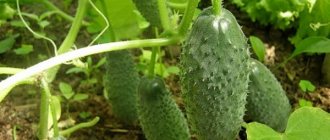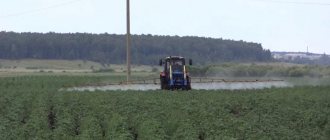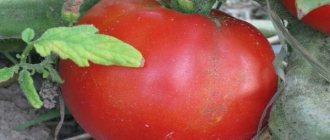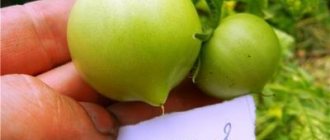The Producer watermelon variety is highly valued by both farmers and consumers. It is grown mainly in the southern regions, but early ripening allows it to be harvested in colder climatic conditions. What work needs to be done during planting, care and harvesting - read in this article.
Watermelon variety “Producer”
watermelon seeds variety “Producer”
The pulp of a ripe watermelon “Producer” is very sweet and contains a large amount of sugar
Description and characteristics of the variety Producer
The Producer variety is an early ripening variety and is characterized by high productivity.
Description:
- Stems. Medium-long. The leaves are gray-green, medium-dissected.
- Berry. Oval in shape, smooth, without dents or roughness, has a characteristic shine.
- Pulp. Red in color, grainy, crispy, juicy, high in sugar (12%), without streaks. The seeds are located near the bark, dark brown, and there are relatively few of them.
- Crust. Not thick, reaches 1 cm when ripe. In color - almost white with a greenish tint.
Berries are considered dietary products and have medicinal properties. They are consumed mainly fresh, but are also suitable for canning, preparing drinks and desserts.
Table of characteristics of the variety Producer:
| Growing season, days | Fruit weight, kg | Productivity, c/ha | Seed germination, % | Transportability | Purpose |
| 65-75 | 8-18 | 105 | 90-99 | high | for fresh consumption |
Preparatory work
Preparatory work before planting will include several stages.
Site selection and preparation
Productivity largely depends on the area where the watermelon will grow. It must meet the following requirements:
- Illumination. Choose an open area, without shade.
- Priming. Sandy and sandy loam soil with an acidity pH = 6.7-7.0 is best suited.
- Groundwater. Set aside an area for the garden bed on a hill where groundwater does not come close to the surface.
- Predecessors. Good predecessors for watermelon are: cabbage, legumes, onions, wheat, alfalfa.
It is not recommended to grow watermelon in an area where melons were grown.
Seed preparation
Preparing seeds for planting follows the same pattern and does not depend on the planting method.
The best germination is observed in seeds stored for 3-5 years.
Preparation stages:
- Calibration Sort seeds by size.
- Soak. Prepare a saline solution (1 teaspoon of table salt per 1 glass of water) and soak the seeds in it. Leave for 10 minutes. Throw away those that float. Dry those that have fallen to the bottom.
- Warming up. Heat the selected material for 20-30 minutes. To do this, use hot water at a temperature of 50-60 °C. As a result of this procedure, disinfection occurs.
- Re-soaking. Prepare a 1% solution of potassium permanganate. Soak the seeds in it for about 20 minutes. The method helps prevent fungal diseases.
- Germination. Place the prepared seeds on damp gauze folded in several layers. After the sprouts appear, they are ready for planting.
Rules for landing
The main criterion for planting is temperature:
- if the soil temperature is below +12 °C, the watermelon will not grow;
- the minimum soil heating temperature should not be lower than +14 °C;
- Optimal temperature conditions are warming up to +20-25 °C.
Growing methods
There are 2 ways to grow watermelon Producer.
Seedlings
In the middle zone and northern regions, so that the watermelon has time to ripen in a short summer, it is better to plant seedlings. Gardeners in the southern regions can also use this method, but watermelon will grow well in open ground.
Landing dates
Seeds for seedlings begin to be sown in mid-April. In this case, by the end of May the seedlings will be well formed and strong for planting in open ground.
Landing technology
Planting is carried out in peat pots.
Subsequence:
- Soil preparation. You can buy a specialized soil mixture for seedlings or prepare it yourself: Option 1 – mix turf soil and humus in a 1:3 ratio.
- Option 2 – mix peat, sawdust and humus in a ratio of 3:1:0.5.
Using peat pots prevents damage to the root system when transplanting into the ground.
- Planting depth. Make holes in the ground in each pot to a depth of 4-5 cm.
- Planting seeds. Plant the seeds pre-sprouted in gauze in peat pots. Cover the seeds with soil without compacting them.
- Soil moistening. Moisten the soil well, but do not flood it.
Seedling care
Further care includes:
- Creating a mini-greenhouse. Cover the planted plants with polyethylene or glass and place them in a place well-warmed by the sun.
- First shoots . You need to wait about 1 month for the first shoots. After they appear, remove the cover and place the seedlings in the sun.
- Hydration . Make sure the lump of earth remains moist. Avoid drying out or overmoistening.
- Hardening . Start hardening the seedlings 10 days before planting in the ground. To do this, take them outside every day. On the first day, leave for 1 hour. Subsequent days - gradually increase this time to the whole day.
Planting seedlings in the ground
Seedlings can be planted in open ground or a greenhouse after 3-5 true leaves appear.
Step by step process:
- Dig holes. Their depth should completely accommodate the peat pot.
- Plant the sprouts. Place the watermelon sprouts along with the glass into the holes.
- Cover with soil. Cover the seedlings with soil, compact the soil around them, but without excessive force.
- Water the sprouts. Moisten the soil near the stems well.
Seeds in the ground
This method is less labor intensive compared to the previous one. You can sow watermelon in the ground in the last days of May.
Sequence of work:
- Number of seeds. Calculate using the formula: per 1 sq. m area – 0.3 g.
- Cultivation. Loosen the area with a cultivator to a depth of 6-7 cm.
- Creating a bed. Divide the area into rows, leaving 1 m between them. In each row, dig holes 3-4 cm deep, at a distance of 0.5 m between them. You can use a scheme of 1.5x0.6 m or 1.4x1.0 m. In greenhouse conditions - 0.7x0.7 m.
- Sowing seeds. Place 2-3 seeds in each hole.
- Sprinkling with earth. Cover the seeds with soil without compacting them.
- Watering. Water the garden bed using warm water.
If the air temperature drops below +12 °C, the bed should be covered with film.
Watermelon needs hot weather (ideally +25-30 °C). When growing in mid-latitudes, gardeners build film canopies over the beds, providing better heating. They are removed at the end of June on a cloudy day or in the evening, so as not to burn the plant in the open sun.
Some gardeners germinate watermelons in open ground using double shelter. The process looks like this:
- seeds are sown in a garden bed;
- cover with a cut-off small plastic bottle;
- cover with another bottle on top, but of a larger volume (3-5 l), creating the conditions of a thermos;
- After warm weather sets in, the bottom bottle is first removed, and after a while the top bottle is removed.
How to plant a watermelon?
When planting Romanza watermelon, adhere to the following rules:
- Landing place. Watermelon does not tolerate any shade. Therefore, an open area is selected - it should not be shaded by nearby buildings or trees; protected from the wind, slightly elevated and well heated. This hybrid is cultivated both in open ground and under cover.
- Seeds. Romanza watermelon seeds are treated with the fungicide Thiram to protect young plants from pathogenic microorganisms and pathogens. They are sown dry directly into the soil without pre-treatment.
- The soil. The plant prefers to grow on sandy and sandy loam fertile soils with a neutral or slightly acidic reaction. When growing watermelons in highly acidic soil, the fruits are small and crack before they have time to ripen.
- Crop rotation. It is recommended to grow the crop in one place for only one year. They return it to this site only after 4 years. And also you should not plant it after nightshade representatives - tomatoes, peppers, eggplants, potatoes and melons - melons, zucchini, squash, pumpkins and watermelons themselves.
- Sowing method. Seeds are sown immediately in open ground or the seedling method is used. However, plants from seeds immediately planted outside grow more resilient. Sowing is done in well-warmed soil - its temperature should not be lower than 15°C at a depth of 8-10 cm. The seedlings are transplanted to a permanent place when the return frosts have passed, and there are 3-4 true leaves on it. Distance between plants: in a greenhouse using trellises - 70x70 cm;
- in open ground - 140x140 cm.
The video below talks about growing Romanza watermelons:
Features of care
Watermelon Producer is a very capricious plant, so it requires good care.
Irrigation rates
Watering depends on the stage of vegetation.
Watermelon is drought-resistant, so watering should be moderate.
Follow these guidelines:
- with increased development of the ovary, water the bed in the morning and evening;
- during flowering, water the plants 2 times a week;
- in good, hot weather - once every 7-8 days;
- at the stage of fruit formation - limit watering;
- When the fruits ripen , watering is stopped completely.
A drip irrigation system is best for watermelon. If the bed is not large, you can use under-bush irrigation. For better passage of water and air to the root system, perform shallow weekly loosening of the soil.
Irrigation by sprinkling can provoke the development of diseases.
In regions with a colder climate and close proximity to groundwater, gardeners make grooves between the rows and water along them, thus the root system does not stretch in depth, but in breadth, which prevents it from rotting.
Top dressing
Fertilizers should be applied during the following growth periods:
- 30 days after planting , when the lashes appear. Use superphosphate 1:15 or mullein - 1:6.
- After the formation of the ovary. Apply mineral fertilizers weekly after watering or rain. The plant has a special need for phosphorus and potassium fertilizers.
Regular fertilizing can be replaced by adding ash or humus to each hole before sowing.
Also, there are some prohibitions for applying fertilizers:
- During fruit ripening, plants should not be fertilized with nitrogen fertilizers. Watermelon is prone to the accumulation of sodium salts, which impairs its taste.
- Fresh manure should not be used for fertilization.
Bush formation
The formation of bushes depends on the method of growing watermelon:
- In open ground. Form a bush from 3 shoots, pinch their tops.
- In the greenhouse. Watermelons are grown on trellises. Form bushes from 1 stem, which you tie to a support. Cut off side shoots longer than 50 cm. Leave 2 stepsons on the main shoot. After the ovary has formed, pinch the tops every 3 leaves.
For friendly ripening, no more than 3 ovaries are left on each shoot.
Fruit ripening
Despite the sun-loving nature, the fruits of the plant ripen better if they are placed in a cloth or, in hot weather, covered with large leaves, for example, burdock.
The fruits should not be allowed to ripen for a long time on open ground, as they may begin to rot. In a greenhouse, each watermelon is placed in nets and hung from trellises to ripen.
Pest and disease control
The producer has a high immunity to the development of diseases such as rot and anthracnose.
But they can be affected by the following diseases and pests:
- Melon aphid. The insect settles on the stems of the crop. Black spots appear on them, and over time the stems curl. In order to defeat the pest, completely remove the affected stems and treat with Fitoverm.
- Putin tick. You can notice the insect immediately after planting the seedlings - it forms a web under the leaves, and a mite can be found in it. Over time, the plant dries out. To prevent the pest from multiplying, burn the affected leaves and treat the bed with an insecticide, such as Agravertine.
- Powdery mildew. The disease is caused by the proliferation of a fungus. The leaves are covered with a white-gray coating on which droplets of liquid form, resembling dew. The plant dies. To treat diseased leaves, remove and treat the plant with a Karatan suspension, Topaz.
- Root rot. The disease develops in the soil and affects the roots, as a result of which brown wet spots can be found on the stems near the ground, which smell unpleasant and yellowed leaves. Treat with copper sulfate, Fundazol or ash.
You can determine the presence of fungus by doing a soil analysis in the laboratory.
There are preventive measures that will help prevent the development of diseases and the proliferation of pests:
- Before sowing, disinfect the soil;
- disinfect the seeds with Fitosporin;
- When watering, do not flood the stems and leaves;
- adhere to the rules and regulations of fertilizing;
- Carry out regular inspection of plants for the presence of lesions.
What are the benefits of watermelon?
Also check out these articles
- Potato variety Adretta
- Diseases of cabbage in open ground
- Geese Linda
- Chereshnya Valery Chkalov
The popularity of watermelons AU The producer says that the variety should have many positive qualities. The advantages of the species and their main qualities are discussed below.
- When properly cultivated in good soil, it produces stable yields.
- Due to the high density of watermelons, they can be transported over long distances. For this reason, the variety is very popular on sale.
- Watermelons can sit for a long time without losing their taste or appearance.
- The variety is resistant to fusarium wilt, powdery mildew, anthracnose, and stem rot.
- Can be grown indoors and outdoors.
Can be grown indoors and outdoors
How can you tell if a berry is ripe?
In the south, watermelon ripens in mid-July, in cool climates - closer to September.
The ripeness of fruits can be determined by the following criteria:
- high contrast of dark green and light green stripes on the peel;
- the texture of the peel changes from matte to glossy;
- Scratches and pecking can often be found on ripe fruits; birds do not touch unripe berries;
- The stalk dries out by the time it ripens.
Harvest and storage
Harvesting begins 5 days before the fruit is fully ripened. At this time, the flesh has a soft pink color, which turns red over time. Berries collected earlier will not be able to ripen under storage conditions, and later they will not be able to be stored for a long time.
Cleaning is best done manually. The watermelon is torn from the stems, leaving 3-5 cm of the stalk.
Watermelons are stored following:
- Temperature and humidity. In storage, the temperature should not be higher than +1-4 °C, humidity within 70-80%.
- Storage method. You can resort to one of 4 methods: in boxes covered with moss;
- in barrels filled with ash;
- in nets in a suspended state, having previously wrapped the watermelon with natural fabric;
- treating each fruit with wax 5 mm thick.
Watering and fertilizing
Proper watering of watermelons includes the following steps:
- regular watering of seedlings and grown seedlings during the formation of ovaries;
- abundant watering by sprinkling during periods of drought - once a week;
- watering during flowering - 2 times a week;
- limited watering during fruit formation;
- cessation of watering during fruit ripening.
Watermelons of the AU Producer variety demonstrate record yields when cultivated in fields using drip irrigation systems. According to reviews of farmers who practice this method, the yield can be up to 106 tons per hectare.
During the growing season, the plantings are fed with nitrogen-phosphorus and potassium mineral and organic fertilizers, after watering the plantings abundantly. During the ripening of berries, nitrogen fertilizers are excluded, otherwise they can contribute to a deterioration in the taste of ripe fruits and the accumulation of nitrate salts in them.
Reviews of watermelon Producer
★★★★★
Maria, 50 years old. The Producer watermelon variety ripens well in our southern climate.
The fruits are very large, juicy, granular and sweet. Of course, the plant is capricious, but with timely agrotechnical work there are no problems with it. ★★★★★
Svetlana, 45 years old. We grow watermelons Producer in a film greenhouse.
We plant the seeds in the second half of April, forming bushes with 1 stem. If spring frosts occur, we additionally heat the greenhouse. Watermelons grow wonderful and sugary. We love this variety very much. ★★★★★
Ermolai, 62 years old. We grow watermelons on an industrial scale and in many varieties.
But Producer is beyond competition: early ripening, high-yielding, with excellent taste, and tolerates transportation well. Hide
Add your review
Watermelon producer is an early ripening variety, which allows it to be grown in short summer conditions. The plant is capricious: it is demanding on climatic conditions, soil, and irrigation. But with timely agrotechnical work, you will be pleased with a good harvest. The producer can be grown both on an industrial scale and in personal farms.
0
0
Copy link
Sowing watermelon seeds in open ground
This method requires minimal time and resources, but is only suitable for southern regions. The best predecessor plants are legumes, wheat and cabbage. Before sowing, the soil is cultivated to a depth of 7 cm. The Producer watermelon variety is distinguished by medium-sized seeds, so they are sown to a depth of 2-4 cm. Sowing time is the end of May. The recommended sowing density is 50 cm between plants and up to 1 meter between rows.
Important! Watermelon is extremely demanding on temperature conditions and does not tolerate frost. Comfortable temperature for plants is 20-25˚С and above. A drop to 12˚C and below poses a threat to the fruit and requires taking measures to cover the seedlings.










